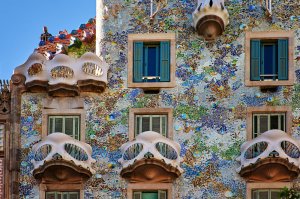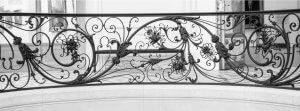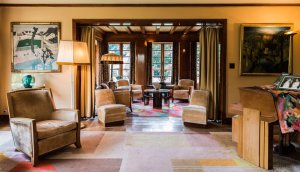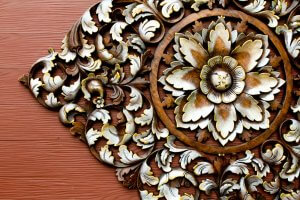Key Characteristics of the Art Nouveau Style

Today, we will be immersing ourselves in the fascinating history of one of the most feminine, sophisticated and meaningful interior design trends the world has ever seen. Full of intricate curves and sinuous, flowing lines, Art Nouveau style interior design formed a very important part of the movement.
The extravagant works that came out of the Art Nouveau movement took much of their inspiration from nature. Stylized floral motifs, feathers, spider web patterns, and feminine silhouettes all feature heavily and are reflected in elements such as wallpaper, stained glass windows, textiles, and furniture.
A style that captures the decadence of iridescent glass and semi-precious gems, Art Nouveau style interior design also found inspiration in the world of jewelry.
The origins of the Art Nouveau style

The Art Nouveau style first emerged in London and Paris toward the end of the 19th Century and the beginning of the 20th Century. The movement aimed to incorporate art into everyday life so that it was present in even the most practical of objects. It came about as an aesthetic reaction to the more traditional artistic and decorative styles of the era.
The first examples of Art Nouveau work were too extravagant for typical Victorian tastes. They were criticized for their elaborate nature and were widely viewed as exaggerated. Several styles influenced the birth of this new movement, including Celtic art and Japanism.
Many different industries began to adopt this new form of artistic expression. One of the greatest examples of this style can be found in the world of architecture, and Gaudi’s extraordinary Casa Batlló.
The worlds of art, jewelry, glassware, graphic design, and even illustration also found inspiration in this new movement. And, of course, it also played a huge role in the world of interior design.
The Art Nouveau style quickly spread around the world. It was known by several different names: in Italy, it was the stile liberty; in Germany, it was called Jugendstil, while in America, it came to be known as Tiffany. While it’s not an easy style to pull off in your own home, the results are definitely worth the effort. Let’s take a look at how to do it!
The Art Nouveau color palette

The colors which characterize the Art Nouveau style are soft shades of gray, mustard yellow, browns, olives, and lilacs. The walls typically feature beautiful and often extravagant prints.
It’s best to use this kind of wallpaper to create a single feature wall in each room while painting the rest in complementary colors.
This muted color palette is repeated throughout the room, and combined with typical Art Nouveau mosaic patterns. These mosaics are interspersed with white tiles, to give it its characteristic look.
Architectural elements

If you’re looking to recreate the Art Nouveau style, there are some basic architectural elements you’re going to need. Pale wood flooring and ornate wrought iron stair rails are just some of the most important aspects to keep in mind.
The ornate frames, floral designs and curving silhouettes typical of Art Nouveau windows are undoubtedly some of the most difficult features to reproduce in modern homes. However, you can use these iconic elements as inspiration for items such as door frames, and decorative moldings. When it comes to this style, they can be as elaborate as you like.
Art Nouveau furniture

Art Nouveau furniture typically featured the same distinctive, flowing lines and brightly colored glasswork found elsewhere. For example, cabinets would often have panels of stained glass with beautiful natural motifs, just like those found on windows.
The furniture was also reminiscent of the rococo style while placing greater emphasis on floral and vegetal forms. These designs became the object of in-depth study during this era.
Designers sought to create the most faithful reflections of these natural forms in all their decorative elements. One of the greatest examples of this is the world-famous Tiffany lamp.
An exquisite decorative style

However, after World War I, there came a time of great industry, which saw Art Nouveau replaced with the Art Deco style. While Art Deco items could easily be mass-produced, Art Nouveau objects were far more costly.
Despite only enjoying brief popularity, Art Nouveau undoubtedly left its mark on the world of interior design. Even today, it’s a style that continues to captivate people around the globe. It’s at the heart of some of the world’s most iconic and feminine spaces, and pays a lasting tribute to the impact art has on our daily lives.
Today, we will be immersing ourselves in the fascinating history of one of the most feminine, sophisticated and meaningful interior design trends the world has ever seen. Full of intricate curves and sinuous, flowing lines, Art Nouveau style interior design formed a very important part of the movement.
The extravagant works that came out of the Art Nouveau movement took much of their inspiration from nature. Stylized floral motifs, feathers, spider web patterns, and feminine silhouettes all feature heavily and are reflected in elements such as wallpaper, stained glass windows, textiles, and furniture.
A style that captures the decadence of iridescent glass and semi-precious gems, Art Nouveau style interior design also found inspiration in the world of jewelry.
The origins of the Art Nouveau style

The Art Nouveau style first emerged in London and Paris toward the end of the 19th Century and the beginning of the 20th Century. The movement aimed to incorporate art into everyday life so that it was present in even the most practical of objects. It came about as an aesthetic reaction to the more traditional artistic and decorative styles of the era.
The first examples of Art Nouveau work were too extravagant for typical Victorian tastes. They were criticized for their elaborate nature and were widely viewed as exaggerated. Several styles influenced the birth of this new movement, including Celtic art and Japanism.
Many different industries began to adopt this new form of artistic expression. One of the greatest examples of this style can be found in the world of architecture, and Gaudi’s extraordinary Casa Batlló.
The worlds of art, jewelry, glassware, graphic design, and even illustration also found inspiration in this new movement. And, of course, it also played a huge role in the world of interior design.
The Art Nouveau style quickly spread around the world. It was known by several different names: in Italy, it was the stile liberty; in Germany, it was called Jugendstil, while in America, it came to be known as Tiffany. While it’s not an easy style to pull off in your own home, the results are definitely worth the effort. Let’s take a look at how to do it!
The Art Nouveau color palette

The colors which characterize the Art Nouveau style are soft shades of gray, mustard yellow, browns, olives, and lilacs. The walls typically feature beautiful and often extravagant prints.
It’s best to use this kind of wallpaper to create a single feature wall in each room while painting the rest in complementary colors.
This muted color palette is repeated throughout the room, and combined with typical Art Nouveau mosaic patterns. These mosaics are interspersed with white tiles, to give it its characteristic look.
Architectural elements

If you’re looking to recreate the Art Nouveau style, there are some basic architectural elements you’re going to need. Pale wood flooring and ornate wrought iron stair rails are just some of the most important aspects to keep in mind.
The ornate frames, floral designs and curving silhouettes typical of Art Nouveau windows are undoubtedly some of the most difficult features to reproduce in modern homes. However, you can use these iconic elements as inspiration for items such as door frames, and decorative moldings. When it comes to this style, they can be as elaborate as you like.
Art Nouveau furniture

Art Nouveau furniture typically featured the same distinctive, flowing lines and brightly colored glasswork found elsewhere. For example, cabinets would often have panels of stained glass with beautiful natural motifs, just like those found on windows.
The furniture was also reminiscent of the rococo style while placing greater emphasis on floral and vegetal forms. These designs became the object of in-depth study during this era.
Designers sought to create the most faithful reflections of these natural forms in all their decorative elements. One of the greatest examples of this is the world-famous Tiffany lamp.
An exquisite decorative style

However, after World War I, there came a time of great industry, which saw Art Nouveau replaced with the Art Deco style. While Art Deco items could easily be mass-produced, Art Nouveau objects were far more costly.
Despite only enjoying brief popularity, Art Nouveau undoubtedly left its mark on the world of interior design. Even today, it’s a style that continues to captivate people around the globe. It’s at the heart of some of the world’s most iconic and feminine spaces, and pays a lasting tribute to the impact art has on our daily lives.







